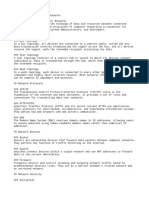Networking Fundamentals & Key Concepts
1. Basic Networking Devices
Device Function OSI Layer Notes
Hub Broadcasts data to all ports Layer 1 Simple, no filtering, rarely used
Switch Sends data only to target MAC Layer 2 Efficient traffic handling
Router Forwards data between networks via IP Layer 3 Connects LANs to WANs
Modem Converts digital ↔ analog signals Layer 1 Needed for ISP connections
DNS Translates domain names to IP Layer 7 Essential for web access
2. OSI Model (7 Layers)
1. Physical – Cables, hubs, modems (bits)
2. Data Link – Switches, MAC addresses (frames)
3. Network – Routers, IP addresses (packets)
4. Transport – TCP, UDP (segments)
5. Session – Manages communication sessions
6. Presentation – Data encryption, compression
7. Application – DNS, HTTP, FTP, Email protocols
3. TCP/IP Model
1. Link – Physical + Data Link
2. Internet – IP, ICMP
3. Transport – TCP, UDP
4. Application – HTTP, DNS, SMTP, etc.
4. High-Speed Communication Fundamentals
- Bandwidth – Data transfer capacity (bps)
- Latency – Delay in transmission (ms)
- Throughput – Actual data transfer rate
- Full-duplex – Data in both directions simultaneously
- Fiber optics – Highest speed for long-distance communication
5. Cybersecurity Attacks
- Phishing – Fake messages to steal credentials
- DDoS – Overloading a server with requests
- Man-in-the-Middle – Intercepting communication
- SQL Injection – Malicious database commands
- Ransomware – Data encryption for extortion
6. Network Topologies
- Bus – Single cable, simple but fault-prone
- Star – Devices connected to a central switch (most common)
- Ring – Devices connected in a closed loop
- Mesh – Multiple redundant paths, high reliability
- Hybrid – Combination of two or more topologies
�7. Domain Name Server (DNS)
A Domain Name Server translates human-friendly domain names (like google.com) into
machine-friendly IP addresses (like 142.250.190.14).
Without DNS, you would have to remember numeric IP addresses for every site you visit.
Types of DNS Servers:
- Recursive Resolver
- Root DNS Server
- TLD Server
- Authoritative DNS Server
Popular Public DNS:
Google: 8.8.8.8 / 8.8.4.4
Cloudflare: 1.1.1.1 / 1.0.0.1
OpenDNS: 208.67.222.222 / 208.67.220.220

























































